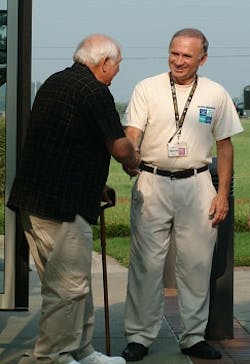After reaching its nadir two years ago, the drug industry’s reputation with the public is inching up in opinion polls, but it has a long way to go before it even approaches the levels it enjoyed during the 1980s. Each drug company is crafting its own public relations strategies and campaigns. Last year, for example, Pfizer launched “Phil the Pill” (since renamed “Pat the Pill”), a campaign that won a P.R. association award, to explain how drugs were developed.
This year, GlaxoSmithKline assigned its sales reps the task of polishing the industry’s public image.
But last August, Talecris Biotherapeutics took a very different approach, by inviting nearly 70 patients who take its therapies for immune deficiencies, hemophilia and other conditions, to visit its Clayton, N.C. facility. They came from 30 states, as well as Canada and Venezuela, to attend the "Up Close and Personal" event, says public affairs manager Lacy McMahon.
The company paid their expenses, and handled all logistics. Given patient privacy issues, it worked primarily through patient advocacy and outreach groups, inviting leaders within those organizations. As a result, Talecris also wound up inviting some patients who are taking competitors’ medicines.
This seems an unusual approach, particularly in an industry which guards its technologies so closely and generally keeps its facilities off limits. On the surface, it might seem merely a pragmatic move: Talecris’ therapies, after all, are used to treat fairly rare illnesses, so advertising on television would not be all that effective.
But in fact, there was more to the decision. Management was convinced, McMahon says, that having patients visit the facility and meet those who produce their medications would improve their view of the company and give them a better understanding of the complexity of developing and producing medicine. In fact, the idea for the event came from top management and the company’s CEO.
A cross-functional team of employees from manufacturing, marketing, security and other departments met frequently to plan the event, which took four months to get off the ground. "Ambassadors" were appointed to meet and greet, escort and spend time with the guests.
Patients, in turn, were required to gown up and were given a complete tour of the facility by plant employees. They then heard from the CEO and head of operations, from the head of R&D, and from those working in manufacturing; a number of patients then shared their stories — how they have been coping with their illnesses, and the difference that the company’s drugs had made in their prognoses. During a Q&A session, a development professional asked pointedly about existing therapies and how convenient or inconvenient they were to take. "If we could give you an ideal therapy, what would that be?" the employee asked.
McMahon says the program was designed specifically to give guests insights into the whole value chain, from plasma collection through to discovery, R&D drug development, manufacturing, QA & QC and distribution.
Surveys of employees and guests after the event provoked strong and positive responses, McMahon says, with one patient calling it "one of the best days of my life." On both sides of the patient/supplier divide, "being able to put a face to the product and to the daily work is special," she says, as it benefits both patients and manufacturing professionals.
To watch a 12-minute video documentary on this project, including patient presentations, click the Download Now button below.




